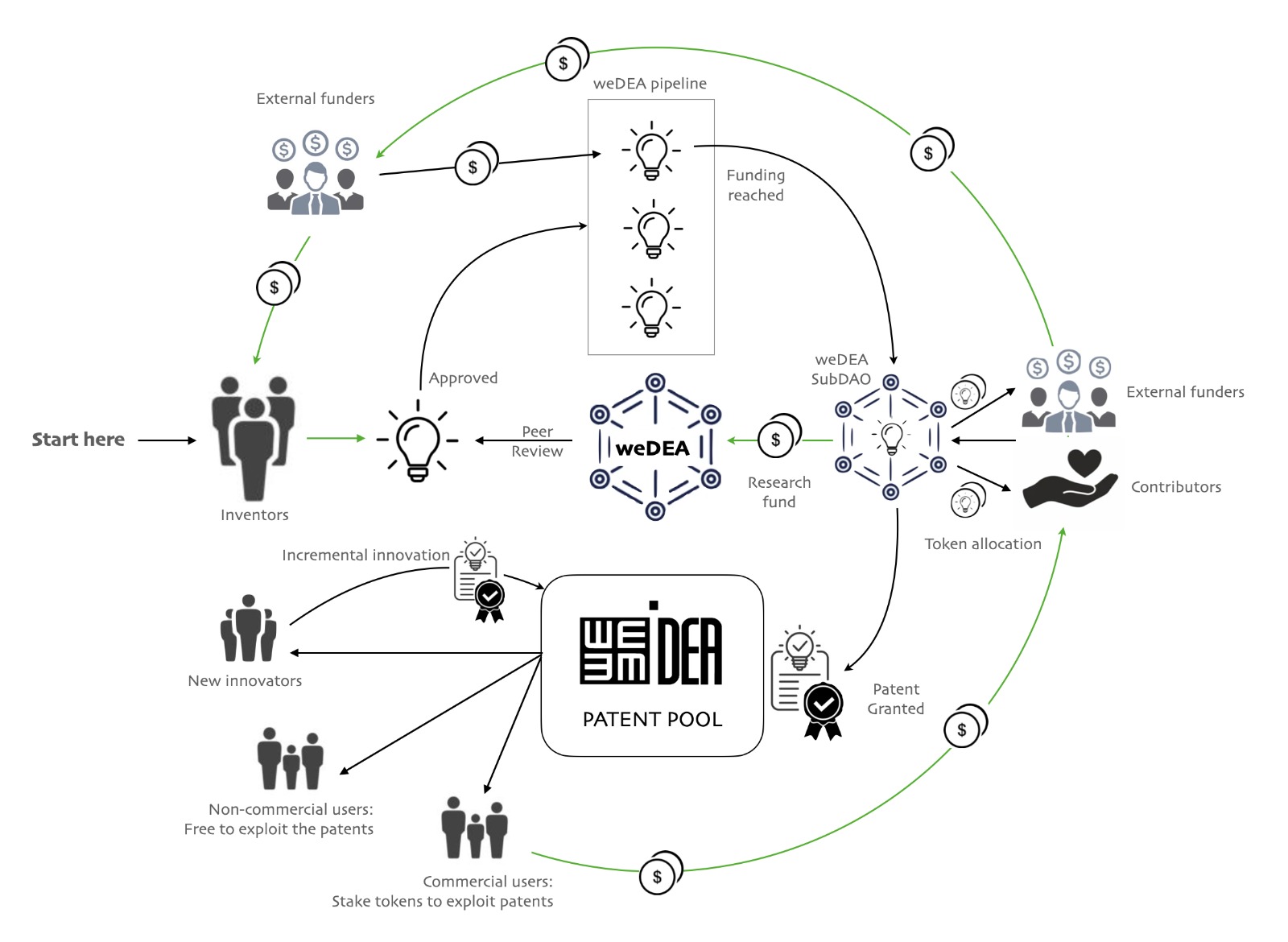weDEA fosters scientific progress and technological innovation by turning inventions into a platform for open and distributed collaboration.
We all know that great ideas can come from anywhere. Whether it’s a scribbled note on the back of a napkin or a “eureka!” moment in the
shower, we’ve all had them. But what separates a great idea from an applicable technology?
The answer is collaboration and co-production.
The power of collaboration has been proven time and time again throughout history. Some of the most iconic inventions were created through collaborative efforts: The light bulb, for example, was invented by Thomas Edison but wouldn’t have been possible without the contributions of many other scientists before him, as well as all those who worked with him on developing and perfecting the technology. And more recently, initiatives like Wikipedia have disrupted entire industries by leveraging collaborative technologies.
We want to bring this process to the world of inventions.
At its core, WEdea fosters scientific progress and technological innovation by turning inventions into a platform for open and distributed collaboration. Because very few people can take an idea from inception to implementation on their own, it often takes a group effort to bring an idea to life. WEdea facilitates this process by bringing people together around common goals.
Invention is a collaborative process, and we want to make it easier for inventors to connect with each other to create the next big thing.
weDEA is a platform that helps inventors bring their ideas to life by connecting them with the resources they need to succeed.
It consists of three key innovations:
The patent system, which was originally meant to support scientific progress and innovation, is effectively limiting them, at every steps of the way.
The patent system encourages individualized approaches to research and innovation, which can be owned and claimed by a single inventor or corporate entity. weDEA enables an open and collaborative approach to research and innovation, by encouraging a multiplicity of actors to cooperate towards the production of a collective idea, or weDEA.
The patent system privileges ideas that can be turned into profitable industrial applications in the short term. weDEA supports the development of all types of ideas: ideas that go from low to high risks, short to long-term, as well as highly impactful projects that require more time to yield results.
The patent system encourages competition and redundancy in research & development, leading to higher costs and inefficiency. The exclusivity of patents promotes a competitive race where the winner takes all, and the others lose all their investments. weDEA fosters a spirit of collaboration, with multiple actors pooling resources together maximizing the probability of solving a problem while minimizing their risks.
Patents are owned by large organizations whose strategy is based on proprietary innovation. In fact, the massive cost and complexity of the equipment and resources required to carry on research justifies the formation of temporary monopolies in the form of intellectual property rights, in order to enable parties to recoup their initial investments. Yet, this solution has two negative collateral effects:
It effectively results in foreclosing access to scientific innovation to the public for a limited period of time.
It hinders innovation by creating gatekeepers that limit access to technological innovation, potentially preventing competitors from commercializing the invention, and precluding other inventors from engaging in incremental innovation on top of existing inventions.
weDEA ensures that inventions cannot be appropriated and remain available for anyone to use and build upon, as well as commercialize through an innovative licensing system.
weDEA provides an alternative approach to the patent system, with higher societal benefits and no drawbacks for innovation and research. weDEA enables a paradigm shift from an exclusionary and individualistic patent system, to an inclusive and collaborative innovation system.
weDEA leverages collective intelligence for better research and development.
It offers new opportunities for open and decentralized collaboration, by relying on
both crowdsourcing and crowdfunding to acquire all the necessary financial and non-financial
resources needed to turn an idea into a patentable invention.
What wikipedia has done for encyclopedias weDEA will do for innovation.
weDEA instrumentalizes the patent system to foster open innovation, using an innovative licensing
scheme to ensure that technological innovations remain always accessible to the public, and cannot be
co-opted by commercial actors engaging in proprietary innovation.
What Creative Commons has done for copyright, weDEA will do for patents.
weDEA leverages web3 technology to reward early investors in innovation.
The platform relies on advanced token economics to provide new and sufficient
economic incentives to invest in research and development early on, with an expectation of returns of
investment which are not based on the exclusivity of the patent system.
What blockchain has done for its early supporters, weDEA will do for everyone.

The life cycle of weDEA.